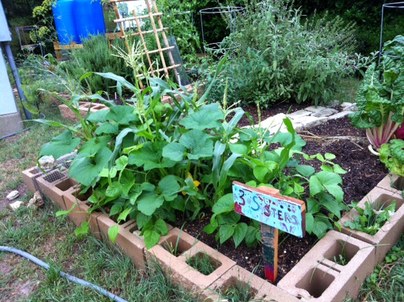




 We are always looking for amazing ways to get outside for math and science. I have been creating math trails over the last month for my math class, and then last week the students created a math trail for the primary students using some of the math concepts that the younger class has been working with. But what about the upper elementary class? One thing they have done recently is to use the stick method to determine the height of trees. All you need is a stick and a measuring tape.  They also worked to determine the diameter of trees after measuring the circumference. The circumference is measured at 4.5 feet up from the ground. Then you divide the circumference by pi (3.14) It is great to estimate before measuring, and then you can always throw in a little subtraction when you determine the difference between the estimate and the actual measurement. A final activity was measuring the canopy of a tree.  Another great way to integrate math and science is with a square foot garden. You can see the string that the students used earlier in the year to mark off the squares after measuring the perimeter and area of the planting space. Once the garden is divided, students must research the plants they want to plant to find out how many plants each square will support. This garden has been harvested and replanted throughout the school year. Growth of plants can be measured, recorded and compared. Another part of gardening is weighing the harvest and recording the data. Then of course you get to use the basil and tomatoes for making lasagna. Integrating math into cooking is another great way to make connections, but that is indoor work for us right now until we get the rest of our outdoor kitchen set up unless we are using the cob oven.  One of the great ways we have created active learning connections outside for our Native American Cultural study is here in the garden where the students set up a "three sisters" garden with Helen (our nature science teacher). We even "planted" a dead fish from our creek to enrich the soil. The corn provides a pole for the beans, the beans stabilize the corn plant and fix nitrogen while the squash acts as mulch preventing evaporation of moisture in the soil. Of course the nutritional elements of these foods adds additional material for learning.  Helen recently noticed there were caterpillars and chrysalises on this mustard plant. Helen brought in a number of books for the students to use to find out what they were seeing. It turned out to be a cabbage butterfly and we all got to see one of them freshly emerged and drying its wings the following week. Today we want to measure the velocity of the creek water by measuring how fast an object travels from point A to point B. This is exciting work since we have had a lot of rain. Some preliminary leg work indicated that there are little whirlpools and lots of other pieces of floating debris that will create additional variables. It might become an even better study of urban trash run off from storms.
0 Comments
Leave a Reply. |
Authors
Archives
August 2023
Categories
All
|
|
CONNECT WITH US
Via the web www.insideoutsideschool.org/contact-us.html EMAIL [email protected] ADDRESS 5530 Killingsworth Lane Pflugerville, TX 78660 |